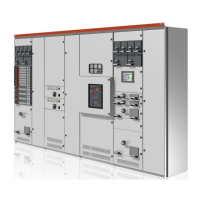64 M O TO R C O NT R O L A N D P R O T E C T I O N U N I T M1 0 X U SE R G U I D E
—
07. Configurable inputs and outputs
• NOP
No special operation for the NOP function, only
for checking digital input status. This input can
be used for status transfer for digital input, and
works in level check mode.
• Start1/Start2
Local hardwiring start control. To activate the
function, control access should be assigned to
‘local’. Start 1 is used for start control in one
direction starters. It is also used for forward start
control in reversing starter control and low speed
start in 2 speed starter. Start 2 is used for reverse
start in reversing starter control and high speed
in 2 speed starter control. Local start control
works on edge trigger, i.e. 0->1 or 1->0.
• Stop
Local hardwiring stop control. To activate the
function, control access should be assigned to
‘local’. Stop control works on either edge trigger
(0->1 or 1->0) or level trigger (continuous 1 or 0).
• Limit1/Limit2
This function is used for applications where limit
switches are installed. When the input is
activated, motor stops and read for starting from
different direction.
Limit1 is usually used for stopping the motor from
running forward (CW); Limit2 is used for
reversing. (CCW).
Limit switch input works on level trigger, i.e. con-
tinuous 1 or 0.
• Process interlock1
The process interlock1 function is used to provide
time dependent trip/alarm/stop features based
on a switch input. This function is used together
with OPERATION DELAY and OPERATION
parameters.
If the hard-wiring signal comes from
the field or other remote source
external of the switchboard, it is
recommended to wire through an
interposing relay internal of the starter
before wired to digital inputs of M10x
relay, 110/240VAC type in particular.
The OPERATION DELAY parameter sets the
amount of time that the process interlock1 switch
can remain inactive on the occurrence of a motor
start. If the switch remains inactive for longer
than this time, a trip/stop will occur. If there is
valid active process interlock1 input detected in
the defined operation delay, motor will keep
running. After the operation delay time, the
inactive status of process interlock1 input will not
affect the running of motor. If the OPERATION
DELAY parameter is set to 0, the process
interlock1 switch must be active while motor is
started, which means motor start will not be
allowed if the input is inactive.
The OPERATION parameter determines whether
process interlock1 feature is a trip (reset required
in order to restart the motor), a stop (no reset
required) or an alarm.
Configurable inputs
There are 13 separate 24VDC configurable digital
inputs (DIs) or 9 separate 110VAC or 230VAC DIs
in M10x. These digital inputs can be assigned to
any of the functions listed below.

